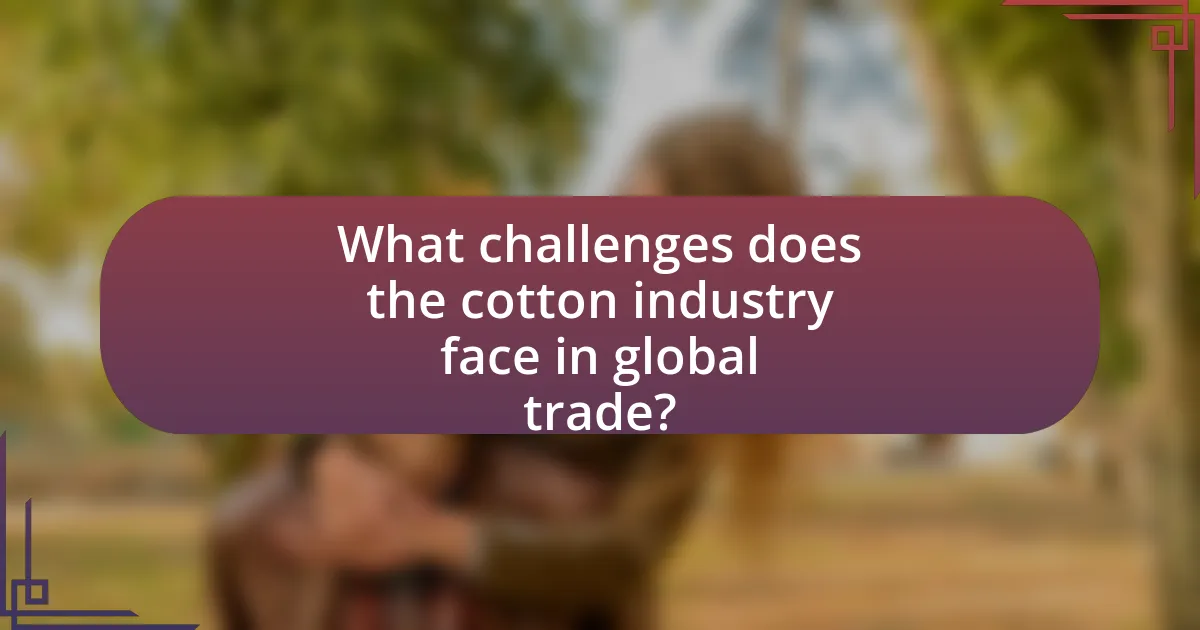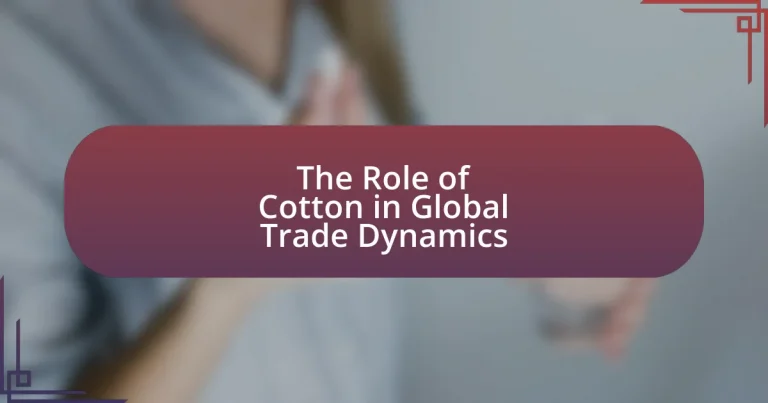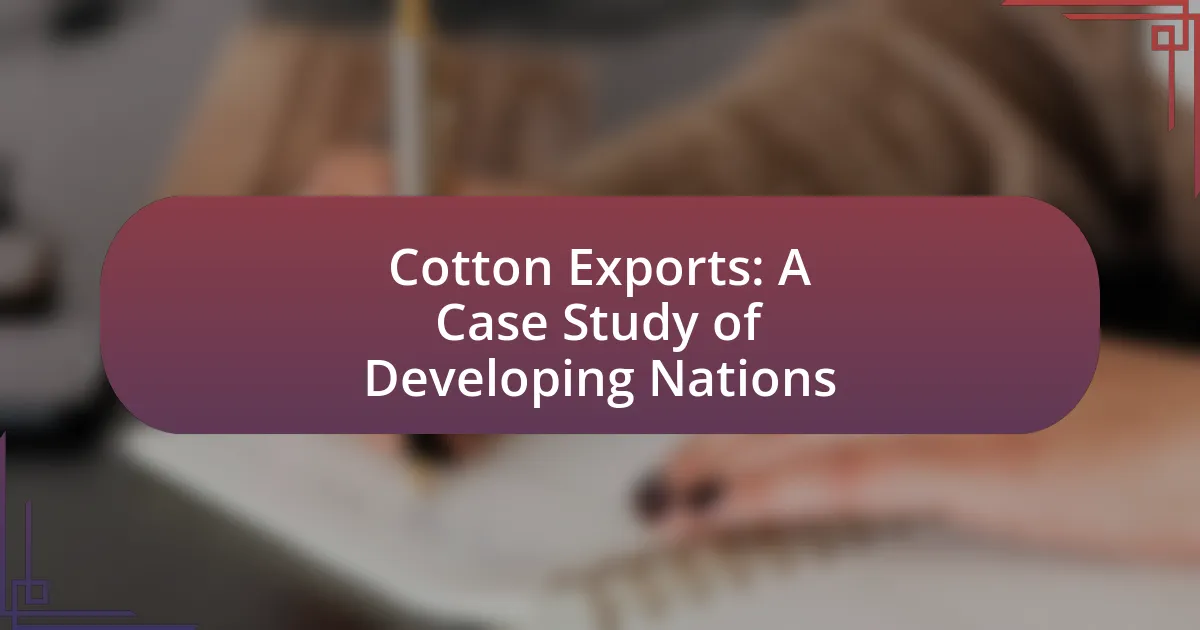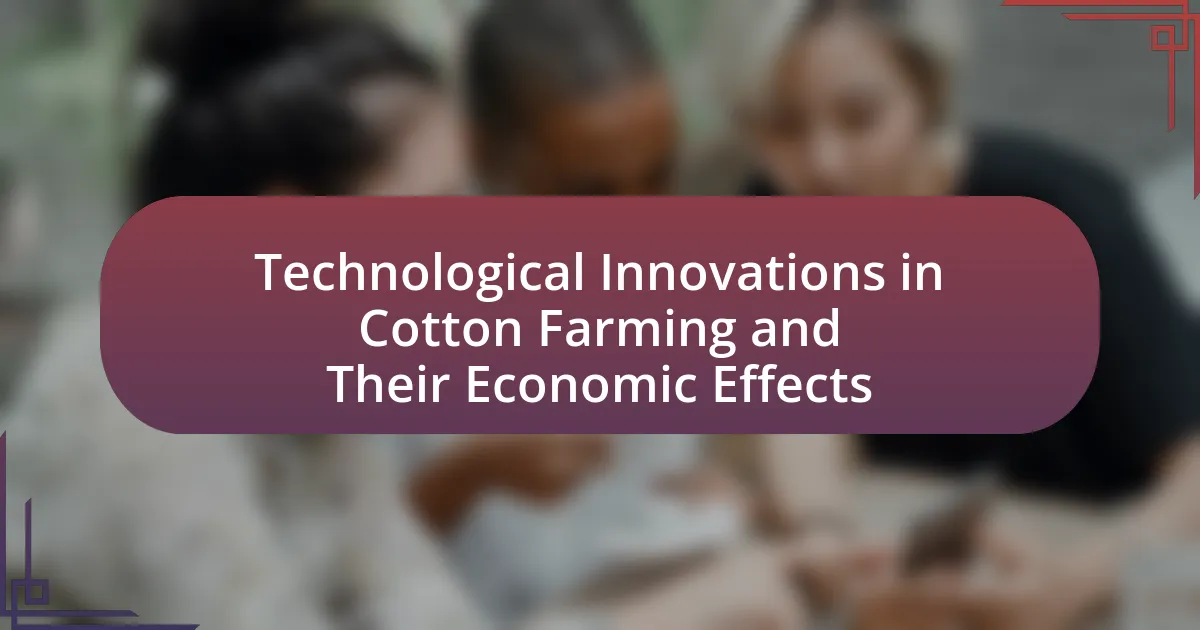Cotton is a vital agricultural commodity that significantly influences global trade dynamics, with exports valued at approximately $8.5 billion in 2021. Major producers, including the United States, China, and India, play crucial roles in supply, while European and Asian countries are key importers. The article explores how cotton has historically shaped international trade patterns, the impact of trade agreements on exports and imports, and the economic factors that contribute to its value. Additionally, it addresses the challenges faced by the cotton industry, including environmental concerns and price fluctuations, and highlights the importance of sustainability practices in enhancing marketability and competitiveness.

What is the Role of Cotton in Global Trade Dynamics?
Cotton plays a crucial role in global trade dynamics as one of the most widely traded agricultural commodities. In 2021, global cotton exports were valued at approximately $8.5 billion, highlighting its significance in international markets. Major producers like the United States, China, and India contribute significantly to supply, while countries in Europe and Asia are key importers. The cotton industry also influences employment and economic stability in many developing nations, where it serves as a vital source of income for millions of farmers. Additionally, fluctuations in cotton prices can impact global textile markets, affecting everything from production costs to consumer prices.
How has cotton influenced international trade patterns?
Cotton has significantly influenced international trade patterns by serving as a key commodity that drives economic relationships between countries. Historically, the demand for cotton, particularly during the Industrial Revolution, led to the establishment of trade routes and the growth of economies reliant on cotton production, such as the United States and India. For instance, in the 19th century, the U.S. became the world’s leading cotton exporter, supplying over 75% of the cotton used in Britain, which in turn fueled the textile industry and shaped global trade dynamics. Additionally, the global cotton market is valued at approximately $50 billion annually, highlighting its ongoing importance in international trade. This commodity continues to affect trade policies, tariffs, and economic partnerships among producing and consuming nations.
What historical events shaped the cotton trade?
The cotton trade was significantly shaped by several historical events, including the Industrial Revolution, the American Civil War, and the establishment of global trade networks. The Industrial Revolution, which began in the late 18th century, increased the demand for cotton due to advancements in textile manufacturing, particularly in Britain, where mechanized spinning and weaving transformed production processes. The American Civil War (1861-1865) disrupted cotton supply from the Southern United States, leading to a global shortage that affected economies reliant on cotton imports. Additionally, the establishment of trade routes and colonial expansion in the 19th century facilitated the spread of cotton cultivation and trade, particularly in India and Egypt, further integrating cotton into global markets. These events collectively influenced the dynamics of the cotton trade, shaping its economic and social implications worldwide.
How do trade agreements impact cotton exports and imports?
Trade agreements significantly influence cotton exports and imports by establishing tariffs, quotas, and trade barriers that can either facilitate or restrict market access. For instance, the North American Free Trade Agreement (NAFTA) reduced tariffs on cotton between the U.S., Canada, and Mexico, leading to increased U.S. cotton exports to Mexico. Conversely, trade agreements that impose high tariffs can limit imports, as seen in countries that protect their domestic cotton industries. According to the U.S. Department of Agriculture, trade agreements have historically led to a 20% increase in U.S. cotton exports since the 1990s, demonstrating their critical role in shaping global cotton trade dynamics.
Why is cotton considered a strategic commodity in global markets?
Cotton is considered a strategic commodity in global markets due to its significant economic impact and widespread use in textiles and apparel. The global cotton market is valued at approximately $50 billion annually, highlighting its importance in trade. Additionally, cotton supports millions of jobs worldwide, particularly in developing countries, where it serves as a crucial cash crop for farmers. The commodity’s price fluctuations can influence global economic stability, making it a key factor in agricultural policies and trade agreements. Furthermore, cotton’s role in sustainable practices and its potential for innovation in textile technology further solidify its strategic importance in the global economy.
What economic factors contribute to cotton’s value in trade?
The economic factors that contribute to cotton’s value in trade include supply and demand dynamics, production costs, global market prices, and trade policies. Supply and demand dynamics significantly influence cotton prices; for instance, when demand for cotton increases in textile manufacturing, prices tend to rise. Production costs, which encompass labor, land, and input costs, also affect cotton’s market value; higher production costs can lead to increased prices. Global market prices fluctuate based on international competition and trade agreements, impacting how cotton is valued in different regions. Additionally, trade policies, such as tariffs and subsidies, can alter the competitive landscape for cotton producers, further influencing its trade value. For example, the U.S. cotton industry benefits from subsidies that can enhance its competitiveness in the global market.
How does cotton production affect global supply chains?
Cotton production significantly impacts global supply chains by influencing the availability and pricing of raw materials for the textile industry. As one of the most widely used fibers, cotton accounts for approximately 30% of the world’s fiber consumption, which directly affects the production costs and supply stability for clothing manufacturers. For instance, fluctuations in cotton prices due to weather conditions, trade policies, or pest infestations can lead to increased costs for textile producers, which in turn affects retail prices and consumer demand. Additionally, countries like China, India, and the United States are major players in cotton production, and their output levels can shift global supply dynamics, impacting trade relationships and logistics. The interconnectedness of cotton production with other sectors, such as agriculture and manufacturing, further illustrates its critical role in shaping global supply chains.

What are the key players in the global cotton trade?
The key players in the global cotton trade include major producing countries, multinational corporations, and international organizations. Major producing countries such as China, India, the United States, and Brazil dominate the market, contributing significantly to global cotton supply. For instance, in 2021, China and India together accounted for over 60% of the world’s cotton production. Multinational corporations like Cargill, Louis Dreyfus Company, and Olam International play crucial roles in the trading and processing of cotton, influencing market prices and trade flows. Additionally, organizations such as the International Cotton Advisory Committee (ICAC) provide data and analysis that shape policies and practices within the industry. These entities collectively drive the dynamics of the global cotton trade.
Which countries are the largest producers and consumers of cotton?
The largest producers of cotton are China, India, and the United States. In 2021, China produced approximately 5.9 million metric tons, India produced around 6.2 million metric tons, and the United States contributed about 3.5 million metric tons to global cotton production.
As for consumption, China is the largest consumer, using around 8 million metric tons annually, followed by India with approximately 6 million metric tons, and the United States consuming about 1.5 million metric tons. These figures highlight the significant role these countries play in both the production and consumption of cotton within the global market.
What role do developing countries play in cotton production?
Developing countries play a crucial role in global cotton production, accounting for approximately 70% of the world’s cotton supply. Countries such as India, China, and several African nations are significant contributors, with India being the largest producer, yielding around 6 million metric tons annually. These nations benefit economically from cotton cultivation, as it provides employment for millions and supports rural livelihoods. Additionally, developing countries often engage in both the cultivation and export of cotton, influencing global market prices and trade dynamics. The reliance on cotton in these regions underscores its importance in agricultural economies and international trade.
How do consumer trends in developed nations affect cotton demand?
Consumer trends in developed nations significantly influence cotton demand by shifting preferences towards sustainable and organic products. As consumers increasingly prioritize eco-friendly and ethically sourced materials, the demand for organic cotton has risen, with the global organic cotton market growing at a rate of approximately 20% annually. This trend is driven by heightened awareness of environmental issues and social responsibility, leading brands to adapt their sourcing strategies to meet consumer expectations. Consequently, cotton producers are compelled to invest in sustainable farming practices to align with these evolving consumer preferences, thereby impacting overall cotton demand in the global market.
What organizations and institutions govern the cotton trade?
The cotton trade is governed by several key organizations and institutions, including the International Cotton Advisory Committee (ICAC), the World Trade Organization (WTO), and various national agricultural departments. The ICAC plays a crucial role in promoting international cooperation and providing data on cotton production and trade. The WTO establishes global trade rules that affect cotton exports and imports, ensuring fair competition among member countries. National agricultural departments regulate domestic cotton markets and implement policies that align with international agreements. These organizations collectively influence the dynamics of the global cotton trade through regulations, data sharing, and trade agreements.
How do international trade organizations influence cotton policies?
International trade organizations influence cotton policies primarily through the establishment of trade agreements and regulations that govern cotton production and trade. These organizations, such as the World Trade Organization (WTO), set rules that member countries must follow, impacting tariffs, subsidies, and market access for cotton. For example, the WTO’s Agreement on Agriculture encourages countries to reduce trade barriers and subsidies, which can lead to more competitive pricing in the global cotton market. Additionally, international trade organizations often facilitate negotiations that address issues like sustainability and fair trade practices, further shaping national cotton policies.
What role do non-governmental organizations play in cotton sustainability?
Non-governmental organizations (NGOs) play a crucial role in promoting cotton sustainability by advocating for environmentally friendly practices and supporting farmers in adopting sustainable methods. NGOs often provide training and resources to farmers, helping them implement practices such as organic farming, integrated pest management, and water conservation techniques. For instance, organizations like the Better Cotton Initiative have established standards that encourage sustainable cotton production, which has led to a reported 20% reduction in pesticide use among participating farmers. Additionally, NGOs engage in policy advocacy, influencing regulations that promote sustainable practices in the cotton industry. Their efforts contribute to reducing the environmental impact of cotton production and improving the livelihoods of farmers.

What challenges does the cotton industry face in global trade?
The cotton industry faces significant challenges in global trade, including fluctuating prices, trade policies, and environmental concerns. Price volatility is driven by factors such as weather conditions, global supply and demand, and competition from synthetic fibers, which can lead to unstable income for farmers. Trade policies, including tariffs and subsidies, vary by country and can create barriers to market access, affecting international competitiveness. Additionally, environmental issues, such as water usage and pesticide application, raise sustainability concerns that can impact consumer preferences and regulatory frameworks. These challenges collectively hinder the cotton industry’s ability to thrive in the global market.
How do environmental concerns impact cotton production and trade?
Environmental concerns significantly impact cotton production and trade by influencing agricultural practices, market demand, and regulatory frameworks. For instance, the use of pesticides and water-intensive irrigation methods has raised sustainability issues, prompting consumers and retailers to favor organic and sustainably sourced cotton. According to the World Wildlife Fund, conventional cotton farming accounts for 24% of global insecticide use, leading to increased scrutiny and calls for environmentally friendly practices. Additionally, countries with stringent environmental regulations may impose tariffs or trade barriers on cotton imports that do not meet sustainability standards, affecting global trade dynamics. This shift towards sustainable practices is reflected in the growing market for organic cotton, which has seen a 50% increase in production from 2015 to 2020, indicating a clear trend towards environmentally conscious consumption.
What are the implications of climate change on cotton farming?
Climate change significantly impacts cotton farming by altering weather patterns, increasing pest and disease prevalence, and affecting water availability. Rising temperatures can lead to reduced yields, as cotton plants are sensitive to heat stress, particularly during flowering and boll development stages. For instance, studies indicate that a 1°C increase in temperature can reduce cotton yields by approximately 10%. Additionally, erratic rainfall patterns can lead to droughts or flooding, both of which adversely affect cotton growth. Increased humidity and temperature also create favorable conditions for pests like the cotton bollworm, which can further diminish crop quality and yield. These factors collectively threaten the sustainability of cotton farming, impacting global trade dynamics as countries reliant on cotton exports face economic challenges.
How do sustainability practices affect cotton’s marketability?
Sustainability practices significantly enhance cotton’s marketability by aligning with consumer demand for environmentally friendly products. As consumers increasingly prioritize sustainable sourcing, cotton produced through organic farming or sustainable practices attracts higher prices and greater market interest. For instance, a report by the Textile Exchange indicates that organic cotton sales reached 300,000 metric tons in 2020, reflecting a 30% increase from the previous year, demonstrating a growing market for sustainably produced cotton. Additionally, brands that adopt sustainable practices often experience improved brand loyalty and reputation, further boosting their marketability in a competitive landscape.
What economic challenges are currently affecting the cotton market?
The cotton market is currently facing several economic challenges, including fluctuating prices, supply chain disruptions, and increased production costs. Fluctuating prices are influenced by global demand and competition from synthetic fibers, which can lead to instability for farmers and producers. Supply chain disruptions, exacerbated by the COVID-19 pandemic and geopolitical tensions, have hindered the timely distribution of cotton, affecting availability in key markets. Additionally, increased production costs due to rising input prices, such as fertilizers and labor, have put pressure on profit margins for cotton growers. These factors collectively impact the overall health and sustainability of the cotton market within the global trade dynamics.
How do fluctuations in global prices impact cotton farmers?
Fluctuations in global prices significantly impact cotton farmers by directly influencing their income and production decisions. When global cotton prices rise, farmers often experience increased revenue, which can lead to expanded production and investment in better farming practices. Conversely, when prices fall, farmers may face reduced income, leading to cutbacks in production, potential debt, and financial instability. For instance, in 2021, cotton prices surged to a decade high, benefiting farmers in countries like India and the United States, while a subsequent drop in 2022 led to concerns about profitability and sustainability among growers.
What are the effects of trade tariffs on cotton exports?
Trade tariffs on cotton exports generally lead to a decrease in export volumes and an increase in prices. When tariffs are imposed, exporting countries face higher costs, which can reduce their competitiveness in international markets. For instance, the U.S. cotton industry has experienced fluctuations in export levels due to tariffs imposed by countries like China, which, in 2018, implemented tariffs that resulted in a significant drop in U.S. cotton exports to China, falling from 1.2 million bales in 2017 to just 0.3 million bales in 2019. This demonstrates how tariffs can directly impact trade dynamics by altering supply chains and pricing structures in the global cotton market.
What strategies can stakeholders adopt to navigate the cotton trade landscape?
Stakeholders can adopt several strategies to navigate the cotton trade landscape, including diversifying supply sources, investing in sustainable practices, and leveraging technology for better market insights. Diversifying supply sources mitigates risks associated with price volatility and supply chain disruptions, as evidenced by the fluctuations in cotton prices due to climate change and geopolitical tensions. Investing in sustainable practices, such as organic farming and water-efficient irrigation, not only meets growing consumer demand for ethical products but also aligns with regulatory trends aimed at reducing environmental impact. Furthermore, leveraging technology, such as data analytics and blockchain, enhances transparency and efficiency in the supply chain, allowing stakeholders to make informed decisions based on real-time market data. These strategies collectively enable stakeholders to adapt to the dynamic nature of the global cotton trade.
How can producers enhance their competitiveness in the global market?
Producers can enhance their competitiveness in the global market by adopting advanced technologies and sustainable practices. Implementing precision agriculture techniques, such as data analytics and IoT devices, allows producers to optimize resource use and increase yield efficiency. For instance, a study by the Food and Agriculture Organization (FAO) indicates that precision farming can boost crop yields by up to 20%. Additionally, focusing on sustainability through organic farming and eco-friendly practices not only meets consumer demand for ethical products but can also lead to premium pricing. According to the Global Organic Textile Standard, organic cotton can sell for 20-30% more than conventional cotton, thereby improving profit margins for producers.
What best practices can be implemented for sustainable cotton trade?
Best practices for sustainable cotton trade include implementing organic farming methods, promoting fair trade practices, and utilizing water-efficient irrigation techniques. Organic farming reduces chemical inputs, which benefits soil health and biodiversity, while fair trade ensures that farmers receive equitable compensation, enhancing their livelihoods. Water-efficient irrigation, such as drip irrigation, minimizes water waste and supports sustainable water management. According to the Textile Exchange’s 2021 report, organic cotton production has increased by 56% over the past five years, demonstrating a growing commitment to sustainable practices in the cotton industry.





